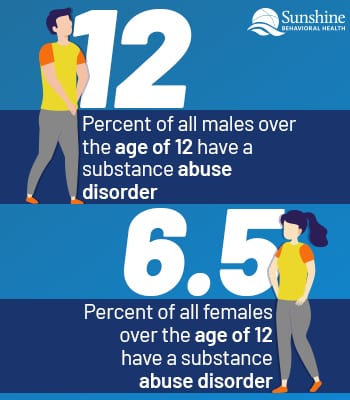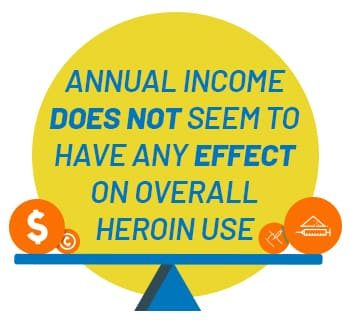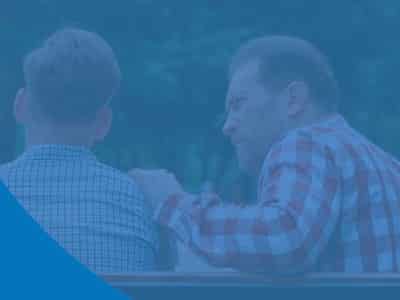Heroin is an opioid. It is made from morphine. The primary ingredient comes from the poppy plants and is commonly turned into a drug that users can sniff, snort, or inject. When we think of heroin, we typically have an image of syringes in our minds, but there are others ways in which to use it.
If you’re not familiar with opioid abuse, it’s likely that you don’t know much about it. Including how common it is and how many people are addicted to heroin? What are the statistics for heroin users by age, gender, or educational level? The following are several heroin use statistics.
Heroin Statistics by Age
Heroin addiction statistics by age can help people understand who is most likely to be abusing this particular drug. Heroin use and overdose deaths for all ages have increased dramatically in recent years. According to the National Institute on Drug Abuse, heroin deaths have gone from 3,036 in 2010 to approximately 15,000 in 2016 and 2017. In 2019 the number of overdose deaths was 14,019.
Heroin use statistics show that the greatest increase in heroin use is among the 18-to-25 age group. Almost all age groups, however, have shown an increase in heroin use and addiction. Use among 12- to 172025olds has decreased slightly. Those with mental health disorders generally have the highest risk of developing drug dependency regardless of age.
 Heroin Statistics in Adults
Heroin Statistics in Adults
How many people use heroin? There are more adults, especially older adults, using heroin than many people may realize. Heroin facts and stats shatter the myth that abuse of this substance is only among those in their teens and twenties.
In recent years the social stigma surrounding heroin use has diminished. What used to be thought of as a “back alley” drug or a substance only homeless individuals use has now become socially acceptable. Heroin use stats reveal that the cost of heroin, compared to prescription drugs, especially drugs such as OxyContin, is usually cheaper. This is important because many people will turn to heroin as a replacement if they can no longer afford or receive prescriptions for painkillers such as opioid drugs.
Heroin Statistics in Seniors
The elderly are not immune from drug abuse or addiction. Heroin addiction statistics for seniors sometimes include research and studies on individuals who are as young as 50 years old. Other statistics, however, quantify seniors as being 65 and older. The National Institutes of Health reports that admissions for heroin treatment for those 65 and older increased from 7.2% to 16% from 1992 to 2008. This increase may be because baby boomers tended to use drugs more frequently during their younger years than most previous generations.
Professionals sometimes refer to those who abuse drugs or alcohol before age 65 as first-level addicts. Those who do so at 65 or beyond are referred to as elderly addicts. Addiction may begin later in life for a variety of reasons. Losing friends and relatives may cause emotional difficulty. The aging process sometimes causes painful physical problems that can lead to drug abuse. Statistics show that approximately 25% of those between the ages of 65 to 69 take at least five prescriptions. That number jumps to nearly 46% among those ages 70 to 79. All of these may be reasons why the elderly are more apt to take illicit drugs such as heroin.
 Heroin Statistics in Teens
Heroin Statistics in Teens
Teen substance use disorder is particularly problematic since many teens are still growing and developing both physically and mentally. Drug use can therefore prove more damaging to younger individuals.
The National Institute on Drug Abuse (NIDA) states that according to a national survey, in 2018, 0.1% of all teens between the ages of 12 and 17 had used heroin at least once. The percentage was 1.3% for those between the ages of 18 and 25. Heroin usage statistics for teens and statistics in pre-pubescents reveal some alarming trends. Some studies have shown that the age when an individual first tries heroin has dropped significantly during the last 50 years.
For those born between 1940 and 1949, the average age of first-time heroin use was 20.5. For those born from 1970 to 1979, first-time use was 16.5. This research went on to show that not only were younger individuals involved in greater drug use, but that they engaged in higher levels of polydrug use, were involved in more crime associated with drug use, and there were increased overdoses associated with younger users of heroin.
Heroin facts and stats show that even younger teens are not immune from heroin use or addiction. The overall findings in these studies indicate the acceptability of heroin use among young people as well as greater access to the drug.
Heroin Statistics According to States
Heroin usage by state presents a diverse picture regarding how many people are addicted to opioids in different regions of the United States.
Research shows that in 2018 the highest number of opioid deaths (including heroin, fentanyl, and opioid prescriptions) occurred in Ohio, Maryland, Massachusetts, New Hampshire, and West Virginia. Each of these states had over 27 deaths per 100,000 individuals. Heroin usage by state reveals that states with between 19.1 and 27 deaths per 100,000 included Vermont, Maine, Connecticut, Rhode Island, Kentucky, Tennessee, Michigan, and Missouri.
There are several reasons why there are higher levels of heroin abuse in the Midwest and Eastern states. High unemployment and poverty rates may contribute to increased drug use in states such as West Virginia and Kentucky. It is possible that those in the Northeast see higher drug use rates because some of these states have higher rates of drug trafficking from Canadian cities such as Montreal through the state to New York City. This may be particularly true of Vermont.
 Heroin Statistics by Gender
Heroin Statistics by Gender
In general, males are more likely to abuse all types of substances at a higher rate than females. Approximately 12% of all males over the age of 12 have a substance use disorder, while about 6.5% of females over the age of 12 have a drug problem. Females, however, are more likely to overdose and experience relapse after receiving treatment than men.
There are distinct differences between males and females in the area of heroin abuse in particular. Females struggling with heroin abuse and addiction are more likely to abuse a smaller amount for shorter times. They are also less likely to inject heroin.
Heroin addiction statistics reveal that even though males still abuse heroin at a higher rate than females, there has been a large increase in female users. There was a dramatic increase in females using heroin from 2002-04 to 2011-13. Females are often influenced by their partners regarding drug use, especially other men in their lives. This is particularly true regarding whether they inject heroin or use it in another capacity.
Heroin Statistics by Ethnicity
According to the Rand Group, heroin use has been rising among all racial and ethnic groups in recent years. During the last decade, however, there have been general changes regarding who is most likely to abuse heroin. There has been a dramatic rise in heroin use and addiction among those who identify as white. Those who identify as Hispanic generally have the lowest heroin addiction and overdose deaths.
Generalized statistics reveal that Asian Americans have the lowest drug abuse and addiction levels of all races and ethnicities. The total population has a substance use disorder rate of 7.4%, while Asians have a rate of 4.8%.
 Heroin Statistics by Education Level and Employment Status
Heroin Statistics by Education Level and Employment Status
There are those who are considered “functioning drug addicts.” These are individuals who hold jobs and seemingly go about their daily lives as well as most other individuals while addicted to drugs. This sometimes occurs when individuals are addicted to substances such as alcohol or cocaine. This does not appear, however, to be the norm in heroin addiction. Most heroin addicts are not simply recreational users but those with a history of long-term unemployment and a history of relapse and recovery.
Annual income does not seem to have any effect on overall heroin use. Those who make less than $20,000 annually had a 62% increase in heroin use, while those making $20,000 to $49,999 saw a 77% increase. Individuals making more than $50,000 saw a 60% increase. Certain drugs, such as cocaine or crack cocaine, are sometimes associated with various socioeconomic levels. Heroin, however, is a substance that is increasingly abused by those at different educational levels.
Heroin Under the Influence Statistics
How many people are driving under the influence of heroin is difficult to calculate for several reasons, including that individuals may be on several substances simultaneously, and law enforcement might only test for something such as alcohol. In 2018, research showed that 2.3% drove under the influence of drugs other than marijuana. To put this number in perspective, 12 million drove under the influence of just marijuana.
Heroin statistics include those that show the connection between prescription drugs and heroin use. Studies estimate that one out of every 15 individuals who use prescription painkillers for non-medical reasons will go on to try heroin within 10 years. This will likely increase the percentage of individuals driving under the influence.
The number of people using heroin while operating a vehicle has likely increased because the rate of heroin abuse has risen in rural areas and smaller cities in recent years. When drug abuse is primarily confined to large urban areas or the homeless population, they are less likely to own or have access to a vehicle.
 Heroin Overdose Statistics
Heroin Overdose Statistics
According to the Centers for Disease Control and Prevention (CDC), approximately 15,000 people died from heroin overdoses in 2018. It is often believed that overdose deaths are due to a user suddenly getting an increased purity level in the heroin they are using. More often, however, overdose is due to the combination of heroin and other substances that depress the nervous system, such as alcohol or painkillers.
Heroin use stats reveal that heroin emergency admissions are on the rise. More medical professionals, as well as heroin users and those who care about them, are using Naloxone to help reverse the effects of a heroin overdose.
Naloxone hydrochloride is a drug that the U.S. Food and Drug Administration (FDA) approved in 1971. This drug has the ability to reverse respiratory failure that can result from heroin as well as other types of opioid overdoses. It can be used by injection or as the brand Narcan™ which is administered as a nasal spray.
Heroin Statistics on Treatment and Recovery
Statistics about heroin also include data on treatment and recovery. While ethnic and racial minority groups represent a high percentage of individuals in recovery programs, they are less likely to finish treatment.
This same study showed how likely someone was to finish treatment was related to not only race and ethnicity but also the type of substance they were seeking treatment for. On average, participants completed recovery programs 57% of the time for alcohol addiction. The completion rate for methamphetamine use was 52%, 46% for marijuana, 39% for crack or cocaine, and only 30% for heroin.
As stated in the section regarding gender, the rise of females using heroin has increased dramatically. Since women become addicted faster and generally find it more difficult to quit and relapse more often, this makes managing treatment more complex.
 Heroin Rates of Relapse
Heroin Rates of Relapse
Rates of relapse for heroin use are high primarily because of how addictive this particular substance can be. Unlike many other drugs, addiction can occur after using heroin only once or twice. Relapse rates for heroin are extremely high, with between 72-88% of individuals relapsing 12 to 36 months after treatment. Relapse rates are higher when the user is a younger age, has a history of injecting heroin, and the user fails to enter an aftercare program following addiction rehab.
Statistics about heroin and relapse rates conclude that heroin is extremely difficult to completely recover from. Relapse rates are high, and many individuals struggle for years with cycles of recovery and relapse. Considering how many people use heroin, there is an overwhelming need for treatment and support services. The following are several resources that can help individuals struggling with heroin and those individuals helping a friend or a loved one overcome heroin addiction. The National Institute on Drug Abuse is a federal agency that supports research and provides information for individuals and families struggling with different types of drug abuse and addiction. SAMHSA can help individuals find the treatment and support they need. Services are free of charge, and they’re open 365 days a year, 24/7. Their national helpline provides assistance for opioid treatment, suicide prevention, and mental health assistance.
Resources for Managing Heroin Abuse
NIDA, National Institute on Drug Abuse
SAMHSA, Substance Use Disorder and Mental Health Services Administration
Sources
Medical disclaimer:
Sunshine Behavioral Health strives to help people who are facing substance abuse, addiction, mental health disorders, or a combination of these conditions. It does this by providing compassionate care and evidence-based content that addresses health, treatment, and recovery.
Licensed medical professionals review material we publish on our site. The material is not a substitute for qualified medical diagnoses, treatment, or advice. It should not be used to replace the suggestions of your personal physician or other health care professionals.







